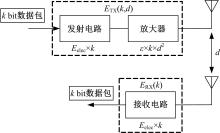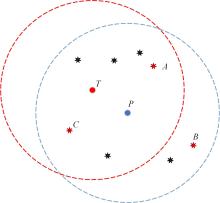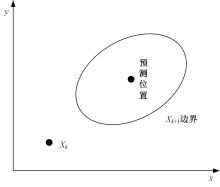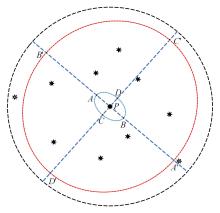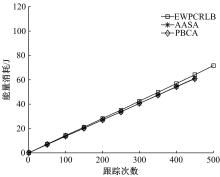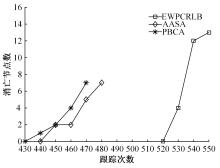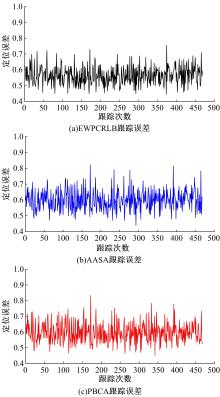Journal of Jilin University(Engineering and Technology Edition) ›› 2022, Vol. 52 ›› Issue (6): 1466-1476.doi: 10.13229/j.cnki.jdxbgxb20210021
Nodes scheduling algorithm based on dynamic cluster in wireless sensor network
Qiang GUO( ),Yu-qiang CUI,Yong WANG
),Yu-qiang CUI,Yong WANG
- College of Information and Communication Engineering,Harbin Engineering University,Harbin 150001,China
CLC Number:
- TN915
| 1 | Hussain M A, Khan P, Kwak K S. WSN research activities for military application[C]∥Proceedings of the 11th international conference on Advanced Communication Technology,South Korea,2009: 271-274. |
| 2 | Rahman G, Wahid K A. LDAP: lightweight dynamic auto-reconfigurable protocol in an IoT-Enabled WSN for wide-area remote monitoring[J]. Remote Sensing, 2020, 12(19): No. 3131. |
| 3 | Saleh N, Kassem A, Haidar A M. Energy-efficient architecture for wireless sensor networks in healthcare applications[J]. IEEE Access, 2018, 6: 6478-6486. |
| 4 | Mendoza E, Fuentes P, Benitez I, et al. Network of multi-hop wireless sensors for low cost and extended area home automation systems[J]. Revista Iberoamericana De Automatica E Informatica Industrial, 2020, 17(4): 412-423. |
| 5 | Hu X Y, Yang L Q, Xiong W. A novel wireless sensor network frame for urban transportation[J]. IEEE Internet of Things Journal, 2015, 2(6): 586-595. |
| 6 | Zheng J, Bhuiyan M Z A, Liang S, et al. Auction-based adaptive sensor activation algorithm for target tracking in wireless sensor networks[J]. Future Generation Computer Systems, 2014, 39: 88-99. |
| 7 | Darabkh K A, Albtoush W Y, Jafar I F. Improved clustering algorithms for target tracking in wireless sensor networks[J]. The Journal of Supercomputing, 2016, 73(5): 1-26. |
| 8 | Zhang S, Chen H, Liu M. Adaptive sensor scheduling for target tracking in underwater wireless sensor networks[C]∥2014 International Conference on Mechatronics and Control (ICMC), Jinzhou, China, 2014: 55-60. |
| 9 | Luo J H, Han Y. A node depth adjustment method with computation-efficiency based on performance bound for range-only target tracking in UWSNs[J]. Signal Processing, 2018, 158: 79-90. |
| 10 | Alaybeyoglu A, Kantarci A, Erciyes K. A dynamic distributed tree-based tracking algorithm for wireless sensor networks[C]∥International Conference on Wireless and Mobile Networks,Ankara, Turkey,2010:295-303. |
| 11 | Wang X B, Fu M Y, Zhang H S. Target tracking in wireless sensor networks based on the combination of KF and MLE using distance measurements[J]. IEEE Transactions on Mobile Computing, 2012, 11(4): 567-576. |
| 12 | Wang Y, Jie H, Cheng L. A fusion localization method based on a robust extended kalman filter and track-quality for wireless sensor networks[J]. Sensors (Basel, Switzerland), 2019, 19(17): No.3638. |
| 13 | Zhang Y, Gao L J. Sensor-networked underwater target tracking based on grubbs criterion and improved particle filter algorithm[J]. IEEE Access, 2019, 7: 142894-142906. |
| 14 | Ren Q, Gao H, Jiang S, et al. An Energy-efficient Object Tracking Algorithm in Sensor Networks[M]. Berlin:Springer Berlin Heidelberg, 2008. |
| 15 | Sha C, Zhong L H, Bian Y, et al. A type of energy-efficient target tracking approach based on grids in sensor networks[J]. Peer-to-Peer Networking and Applications, 2019, 12(5): 1041-1060. |
| 16 | Ahmad T, Abbas A M. EEAC: An energy efficient adaptive cluster based target tracking in wireless sensor networks[J]. Journal of Interdisciplinary Mathematics, 2020, 23(2): 379-392. |
| 17 | Toumi M, Maizate A, Ouzzif M. Dynamic cluster algorithm for improving percolation of targets in a sensor network[J]. Egyptian Informatics Journal, 2019, 20(3): 179-191. |
| 18 | Wang G J, Bhuiyan M Z A, Zhang L. Two-level cooperative and energy-efficient tracking algorithm in wireless sensor networks[J]. Concurrency and Computation: Practice and Experience, 2010, 22(4): 518-537. |
| 19 | Aydogmus O, Talu M F. Comparison of extended-kalman and particle-filter-based sensorless speed control[J]. IEEE Transactions on Instrumentation and Measurement, 2012, 61(2): 402-410. |
| 20 | Heinzelman W R, Chandrakasan A, Balakrishnan H. Energy-efficient communication protocol for wireless microsensor networks[C]∥Proceedings of the 33rd Annual Hawaii International Conference on System Sciences, Maui, HI, USA, 2000: 1567-1576. |
| 21 | Deldar F, Yaghmaee M H. Designing a prediction-based clustering algorithm for target tracking in wireless sensor networks[C]∥2011 International Symposium on Computer Networks and Distributed Systems (CNDS) Tehran, Iran, 2011: 199-203. |
| 22 | 周非, 安康宁, 范馨月, 等. 无线传感网络中基于误差椭圆的自适应节点选择目标跟踪算法[J]. 传感技术学报, 2017, 30(10): 1548-1553. |
| Zhou Fei, An Kang-ning, Fan Xin-Yue, et al. Target tracking in wireless sensor network based on error ellipse and adaptive selection of nodes[J]. Chinese Journal of Sensors and Actuators, 2017, 30(10): 1548-1553. | |
| 23 | Keshavarz-Mohammadiyan A, Khaloozadeh H. Interacting multiple model and sensor selection algorithms for manoeuvring target tracking in wireless sensor networks with multiplicative noise[J]. International Journal of Systems Science, 2017, 48(5): 899-908. |
| [1] | Jian-po LI,Mei-lin LI,Tao YANG,Peng XUE. Low-complexity Wiener filter channel estimation algorithm in massive MIMO-OFDM system [J]. Journal of Jilin University(Engineering and Technology Edition), 2022, 52(1): 211-218. |
| [2] | Da-yang SUN,Xue-ying WANG,Shuang-xue HAN,Hui ZHONG,Jiang-nan DAI. Non⁃line⁃of⁃sight identification and optimization based on virtual coordinates of anchors [J]. Journal of Jilin University(Engineering and Technology Edition), 2021, 51(6): 2207-2215. |
| [3] | Jian-po LI,Peng XUE,Tao YANG,Mei-lin LI. Pilot contamination suppression method for massive MIMO system based on divided pilot reuse [J]. Journal of Jilin University(Engineering and Technology Edition), 2021, 51(6): 2225-2236. |
| [4] | Yi LIU,Ling-ling XIAO,Gai-jing WANG,Wu-jun ZHANG. Resource allocation algorithm based joint optimization for D2D communications in cellular networks [J]. Journal of Jilin University(Engineering and Technology Edition), 2020, 50(1): 306-314. |
| [5] | Cui-ran LI,Yong-sheng YU,Jian-li XIE. Dynamic game algorithm for spectrum sharing based on priority of secondary users [J]. Journal of Jilin University(Engineering and Technology Edition), 2020, 50(1): 315-323. |
| [6] | Jin-peng WANG,Zheng-peng YE,Fan CAO,Nian-yu ZOU. Cooperative distributed antenna transmission method based on co-channel interference in 5G mobile communication system [J]. Journal of Jilin University(Engineering and Technology Edition), 2020, 50(1): 333-341. |
| [7] | Wen-jun LI,Qiang HUA,Li-dong TAN,Yue SUN. An improved algorithm for combination of DV-HOP and RSSI [J]. Journal of Jilin University(Engineering and Technology Edition), 2019, 49(5): 1689-1695. |
| [8] | Peng-yu WANG,Shi-jie ZHAO,Tian-fei MA,Xiao-yong XIONG,Xin CHENG. Vehicle multi-sensor target tracking and fusion algorithm based on joint probabilistic data association [J]. Journal of Jilin University(Engineering and Technology Edition), 2019, 49(5): 1420-1427. |
| [9] | Hong-yan WANG,Yun-fei FANG,Sheng-qi ZHU,Bing-nan PEI. DOA estimation method considering mutual coupling effect in presence of non⁃uniform noise [J]. Journal of Jilin University(Engineering and Technology Edition), 2019, 49(5): 1706-1714. |
| [10] | Yong LIU,Fang⁃shun DENG,Xiao⁃lin LIU,Si⁃jie MIN,Peng WANG. Frequency estimation of minimum shift keying signal based on dual chaotic oscillator [J]. Journal of Jilin University(Engineering and Technology Edition), 2019, 49(4): 1357-1362. |
| [11] | Hong⁃zhi WANG,Fang⁃da JIANG,Ming⁃yue ZHOU. Power allocation of cognitive radio system based on genetic particle swarm optimization [J]. Journal of Jilin University(Engineering and Technology Edition), 2019, 49(4): 1363-1368. |
| [12] | ZHOU Yan-guo,ZHANG Hai-lin,CHEN Rui-rui,ZHOU Tao. Two-level game approach based resource allocation scheme in cooperative networks [J]. Journal of Jilin University(Engineering and Technology Edition), 2018, 48(6): 1879-1886. |
| [13] | SUN Xiao-ying, HU Ze-zheng, YANG Jin-peng. Assessment method of electromagnetic pulse sensitivity of vehicle engine system based on hierarchical Bayesian networks [J]. 吉林大学学报(工学版), 2018, 48(4): 1254-1264. |
| [14] | DONG Ying, CUI Meng-yao, WU Hao, WANG Yu-hou. Clustering wireless rechargeable sensor networks charging schedule based on energy prediction [J]. 吉林大学学报(工学版), 2018, 48(4): 1265-1273. |
| [15] | DING Ning, CHANG Yu-chun, ZHAO Jian-bo, WANG Chao, YANG Xiao-tian. High-speed CMOS image sensor data acquisition system based on USB 3.0 [J]. 吉林大学学报(工学版), 2018, 48(4): 1298-1304. |
|
||
